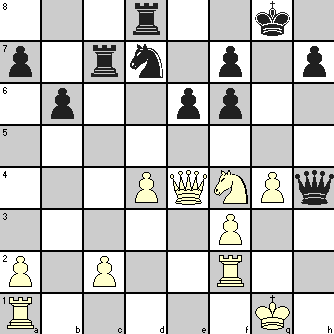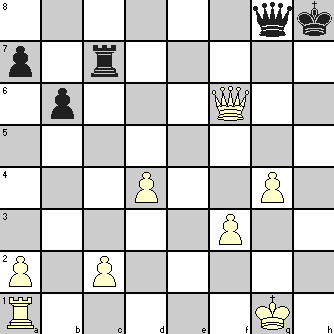Initiative is derived from initiate, which is to originate or start something. In chess, initiative means the ability to take control of the game. You are said to have the initiative when you force the opponent to follow your lead (passive play) rather than initiate something on his own (active play). In Chess Sacrifice as Chess Tactics, we included the use of chess sacrifice as a tool to gain initiative.
Initiative can be gained in several ways like:
- making an active move that forces the opponent to react only in a certain way, restricting his choice
- creating pressure on opponent’s position that keeps him busy resisting that pressure
- playing with tempo i.e., creating a threat to win something
As initiative gives you advantage in play, your aim should be to gain and retain it. If you find that retreating a piece means loss of time, you can retain initiative by exchanging the piece. On the other hand, when you exchange your active piece with a passive piece of your opponent, you lose initiative.
To gain and retain initiative, you must play actively and making a sacrifice is a chess tactics that often constitutes such play. It is said that all sacrifices come about because of some weakness in your opposition’s position. But the presence of a weakness does not create any disadvantage for the opponent unless you are not only able to recognize it but can also make moves to exploit it to your own advantage and a sacrifice often helps you to seize the initiative immediately.
The illustrative game was played at St. Petersburg in 1909 between Ossip Bernstein and Eugene Znosko-Borovsky.
Ossip Bernstein (1882-1962) was a strong Russian master of his time and became Moscow Champion in 1911. Though a doctorate in law, a successful financial lawyer and a businessman, it seems he was plagued by financial misfortunes. He lost his initial fortune due to Bolshevik Revolution in 1918, which forced him to move to France and settle there. He lost again in the Great Depression of 1930 and the third time in 1940 when Nazi Germany invaded France. He was awarded GM title in 1950. He had a near level record against all the great players of his time excepting Capablanca and Alekhine.
Eugene Znosko-Borovsky (1884-1954) had defeated many of his more famous contemporary masters but could not reach the very top level because of many disruptions in his life. He came to be better known for his chess writings than for his games. He settled in France in 1920 where, besides being a writer on chess, he became a literary and drama critic.
The diagram shows the position after Black’s 22nd move (22. … Qxh4) which was considered risky compared to the alternative 22. … Kh8. When Black played his 23rd move, White immediately identified an opportunity to seize initiative by making a sacrifice! He must have noticed the unguarded Black Rooks, the threat to which formed a part of his attacking plan.

| 23. | Rh2 | Qg5 | Aside from 23. … Qg3+ which could get the Queen trapped, this was the only square available, all because of Black’s risky 22nd move in accepting the pawn sacrifice offered by White to open the h-file | |
| 24. | Nxe6 | fxe6 | The Knight sacrifice opened the e-file and a2-g8 diagonal for White’s Queen | |
| 25. | Qxe6+ | Kh8 | 25. … Kf8 26. Qd6+ wins the Rook on c-file 25. … Kg7 26. Qe7+ Kg8 27. Qxd8+ wins both the Rooks 25. … Kg7 26. Qe7+ Kg6 27. Qxh7# |
|
| 26. | Qe7 | Qg8 | ||
| 27. | Rxh7+ | Qxh7 | You can see how White maintains initiative by exploiting Black’s weaknesses and forced Black’s responses! | |
| 28. | Qxd8+ | Nf8 | Black offered the Knight to save the Rook | |
| 29. | Qxf8+ | Qg8 | ||
| 30. | Qxf6+ | Resigns | Black has lost all the K-side pawns, and White’s three passed pawns with a balance in pieces make the win a certainty. Does it remind you of the end position in Chess Sacrifice as a Chess Tactics: creating passed pawn? |
The final position when Black resigned.

You also notice how a sacrifice made for a particular objective often create many other benefits which by themselves would be justification for the sacrifice. If you analyze, you will find that the sacrifice of the KRP and the Knight created all these themes for sacrifices discussed in earlier articles – diverting a piece, opening up lines of attack, breaking up King’s castle, seizing initiative, attacking the King, threatening mate or capture of pieces, creating passed pawns – all in a cascading effect!
Watch Actual Game
httpv://www.youtube.com/watch?v=esJ2xWGE6DU


18 Comments
The game was not at GM level Qxh4 is blunder, not only because it will open the file but it gives white the initiative flow of moves. Which is shown in the game after white forces the queen to move and then knight sac.
playing e6 for e4 is a courageous move.
Hey
can you explain the move
25. Qxf6+ Kh8
how did that happen? If i play the moves after the given position there is no way to reach Qxf6+, i think you made a mistake it should have been Qxe6+ after the position and moves given..
please clarify
@Locky
So it would seem, mistakes do happen when playing through a game.
@Locky
You are right and the text has been corrected. Thanks for pointing out.
This article reminds me of a famous quote “The stomach is an essential part of the Chess master” by – Bent Larsen.
Thanks for posting such an article.
@Chess king
Absolutely right!
Thanks for the quote and your appreciation.
This opening sucks, I guess the best reply for e4 if you are playing for a win as black would be to go for c5 and play a Sicilian so that you can gain some advantage as the game progress and further increase your chance of winning. e4 and then e6 is such a dull reply, e6 is really not something you would want to play if you are serious. So I think the start was awful for the black player. I would say c6 would have been good as well with caro-kann variation but French is just a dull opening and this variation is worst of them all, for a beginner i say go with ruy lopez and learn it well.
You should put the game as well so we can just watch it as you did in your last piece. This game lacked one thing, black player did not analyze the position before making the move Qxh4, moves that open a or h lines with king on the corner should not happen at that level, and the actual move is not h4 and Qxh4 I think this is where a tactical blow comes into play, the main move in this combination is Nxe6 after which white gets to give checks and capture pieces.
@Joker
Game is up there now, had some issues earlier.
@Ash
Chess players do get tired.
@Ashish
Agreed. From the brief introduction it will be clear that the game was not at GM level. It was chosen just to illustrate the point of seizing initiative when your opponent makes a blunder.
@Mark B
Well, what Black played, he played like that, so no point in what could have been. I told that Znosko-Borovsky was better known for his writings than for his chess playing! Bernstein was a strong player and the game was to show how quickly a good player can identify a bad move!
@Joker
I have to add that Black probably miss calculated something with Qxh4 capture, he should have probably seen the next 3 moves, at that level of game, 2-3 moves are easy to calculate.
Wanted to add this line—–
@Ashish
“””Eugene Znosko-Borovsky (1884-1954) had defeated many of his more famous contemporary masters but could not reach the very top level because of many disruptions in his life. He came to be better known for his chess writings than for his games. He settled in France in 1920 where, besides being a writer on chess, he became a literary and drama critic.””””
that says it all, the guy was going through hard times.
Ya its really a courageous move and little risky, but all should know that “no risk no gain”
@Raz
But a time comes when you have to understand if it is a case of “no risk no gain” or “all risk no gain”! That is why in our article 10 steps to raise your game the first two points were “know thyself” and “know thy opponent”. Here Black knew both, so he should have been a little wiser!
@Mark
French opening is not that bad, there are many good games by black in those lines but this game was more of an example than anything else. Some games are easier to convey a message than others.
@Raz In Chess you have to take RISKS and isnt every move a RISK?
Trackbacks/Pingbacks